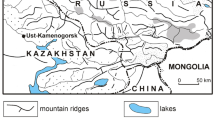Abstract
absolute time period: c. 600,000–200,000 b.p. dated by biostratigraphic, palynological, paleomagnetic, and oxygen-isotope correlations and uranium series, amino acid racemization, and thermoluminiscence determinations from the bottom to the top of the cave deposit.
Access this chapter
Tax calculation will be finalised at checkout
Purchases are for personal use only
Similar content being viewed by others
Suggested Readings
Binford, Lewis, and Ho Chuan Kun (1985). “Taphonomy at a Distance: Zhoukoudian the Cave Home of Beijing Man?” Current Anthropology 26: 413–443.
Boaz, Noel T., Russell L. Ciochon, Xu, Qin Q., and Lin Gin Y. (1999). “Large Mammalian Carnivores as Taphonomic Factor in the Bone Accumulation at Zhoukoudian.” In International Symposium on Palaeoanthropology: In Commemoration of the 70th Anniversary of the Discovery of the First Skull of Peking Man at Zhoukoudian, 41.
Ho, Chuan Kun (1995). “Were Beijing Man and Gigantopithecus the Hunters or the Hunted?” Bulletin of the National Museum of Natural Science 5: 163–177.
Jia, Lan P., and Huang Wei W. (1990). The Story of Peking Man. Beijing: Foreign Languages Press.
Rolland, Nicholas (1999). “Cave Occupation, Fire-making, Hominid/ Carnivore Coevolution, and the Middle Pleistocene Emergence of Home-bases Settlement Systems.” In International Symposium on Palaeoanthropology: In Commemoration of the 70th Anniversary of the Discovery of the First Skull of Peking Man at Zhoukoudian, Abstract, 15.
Rowlett, Ralph M. (1999). “Fire Control by Homo erectus in East Africa and Asia.” In International Symposium on Palaeoanthropology: In Commemoration of the 70th Anniversary of the Discovery of the First Skull of Peking Man at Zhoukoudian, Abstract, 30.
Schick, Kathy D., and Z. A. Dong (1993). “Early Palaeolithic of China and Eastern Asia.” Evolutionary Anthropology 2 (1): 22–35.
Weiner, S., Q. Xu, P. Golberg, J. Liu, and O. Bar-Yosef (1998). “Evidence for the Use of Fire at Zhoukoudian, China.” Science 281: 251–253.
Wu, Xin Z., and Frank Poirier (1995). Human Evolution in China. New York: Oxford University Press.
Zhang, Sen Shui (1985). “The Early Palaeolithic of China.” In Palaeoanthropology and Palaeolithic Archaeology in the People’s Republic of China, ed. R. K. Wu and J. W. Olsen. Orlando: Academic Press, 147–186.
Zhou Ming Zhen, and Ho Chuan Kun (1990). “History of the Dating of Homo erectus at Zhoukoudian.” In Establishment of a Geologic Framework for Paleoanthropology, ed. L. F. Laporte. Boulder: Geological Society of America, Special Paper 242, 69–74.
Author information
Authors and Affiliations
Editor information
Editors and Affiliations
Rights and permissions
Copyright information
© 2001 Springer Science+Business Media New York
About this chapter
Cite this chapter
Ho, C.K. (2001). Zhoukoudian. In: Peregrine, P.N., Ember, M. (eds) Encyclopedia of Prehistory. Springer, Boston, MA. https://doi.org/10.1007/978-1-4615-1189-2_41
Download citation
DOI: https://doi.org/10.1007/978-1-4615-1189-2_41
Publisher Name: Springer, Boston, MA
Print ISBN: 978-1-4684-7130-4
Online ISBN: 978-1-4615-1189-2
eBook Packages: Springer Book Archive




